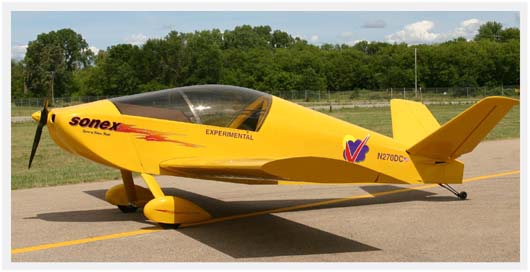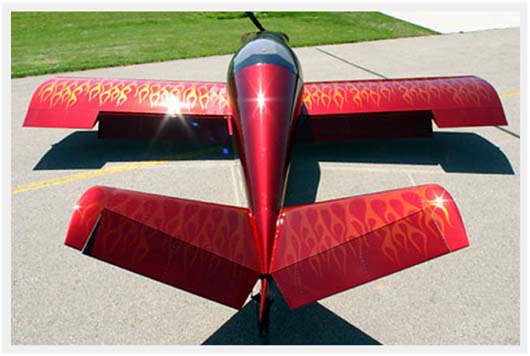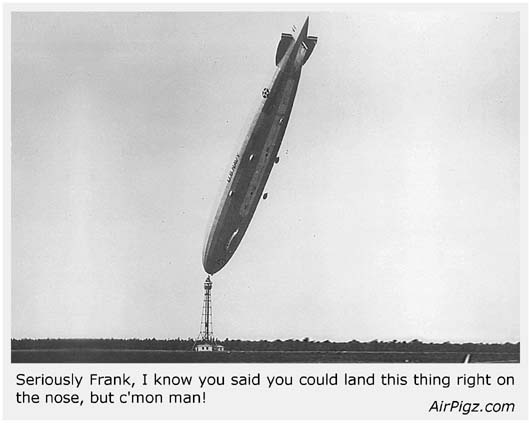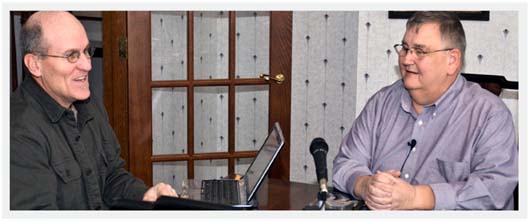My dad, Robert J Clupper, passed away after a sudden unexpected illness in Jacksonville, Florida. He was just short of 80 years old. He'd been living full-time in a motorhome for the last 10 years or so, and much of the last 3 were spent parked in my driveway in Indiana when he wasn't out on a trip somewhere across America.
The following pictures and captions are a small snapshot of the amazing life he lived in the world of aviation. He was never more comfortable or happy than when his feet were off the ground.
He was a great dad who taught me to be honest, to be kind to others, and to trust Jesus Christ. Thanks dad, for loving me like you did.
'DC-3's to 747's, who could ask for more'
(He put that saying at the top of his letters since about 1985)

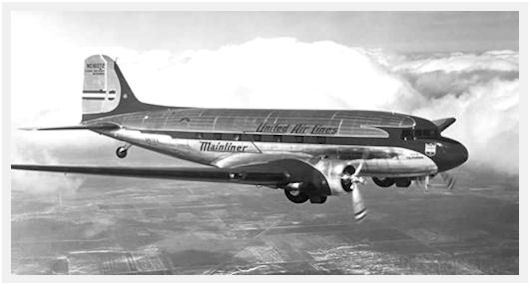

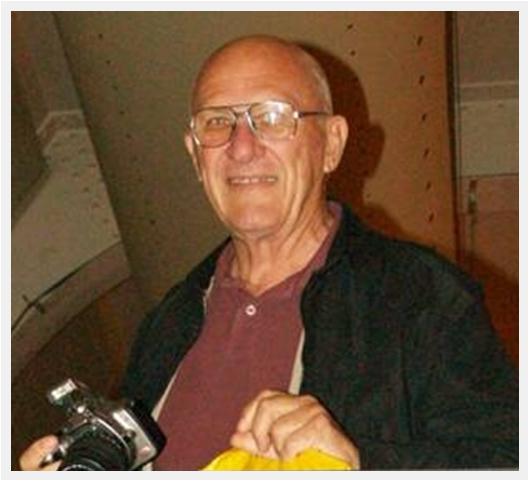
The top pic is my dad as a United Airlines DC-6 Captain, probably taken in the mid-60's. It's absolutely my all time fave pic of him. He was hired by UAL in June of 1952 as a co-pilot on DC-3's. In 1971, not long after UAL put the 747 into service, he went online as co-pilot. The 747 was by far his favorite airliner to fly... there wasn't anything about that machine that he didn't like.
When he retired from UAL in 1987, he had well over 10,000 hours on the 747 alone! He stayed with the airplane as the senior co-pilot until he could switch seats, bypassing flying the DC-10 as Captain as the other pilots did. We were pretty sure he had more 747 time than any other pilot at United when he reitred after 16 years straight of flying it to places like Honolulu, Hawaii & Tokyo, Japan.
He was always very greatful to UAL for the opportunity to fly their airplanes. He was also honored to have been selected as 'Flight Crew Member of the Year' in 1985 for how he handled a bomb scare on one of his flights. The bottom pic is from late 2007 when my wife and I took him up to the Henry Ford Museum in Dearborn, Michigan. They've got some great aircraft on display there and as always, he had his camera along to get some more pictures.
He was in pretty good health right up until the end, though he had a pacemaker put in several years back and had a mild heart attack just a few years ago.
He was admitted to the hospital in Jacksonville on Wednesday 1-7-09 and passed away peacefully Saturday afternoon 1-10-09. I tried hard to make it to him in time, but airliner mechanical troubles and weather delays slowed me down. He passed about an hour before I got there. However, as it turned out, he'd been sedated since the day before, so we wouldn't have been able to talk.... I do wish I'd been able to hold his hand though.
We had talked many times about how he was ready to meet God. He had no fear of death. He was looking forward to eternity with Christ!
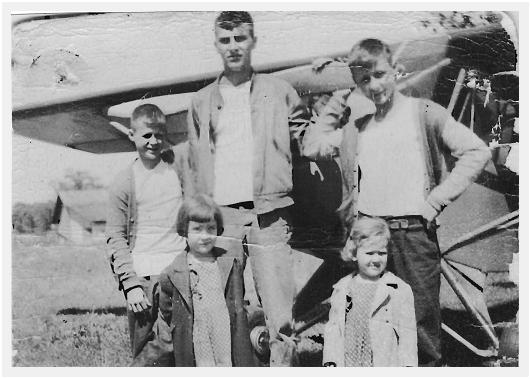
My dad was born in the really small town of La Fontaine (say La Fountain) in northern Indiana in 1929. When he was just 8 years, he got a ride in a Ford Tri-Motor that was traveling around the country. From that day on, without any doubt, he knew he wanted to be an airline pilot!
He took flying lessons at the Marion, Indiana airport and soloed when he was 16. His dad then bought an Aeronca Defender, a model before the Champ, and he built up a lot of local fun flying time in it. This pic shows him with two cousins, as well as his younger sisters Carol and Nancy.

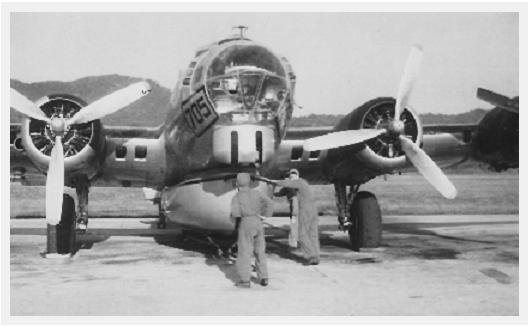

He joined the Air Force right after graduating high school in 1947. The recruiter told him he'd have no trouble getting to fly airplanes, but with WWII recently over, the military had more pilots than they needed. He wound up instead as a crew chief on a B-17 in a rescue squadron based in Panama.
I'm pretty sure his aircraft was the one marked '705' in the top pic. He always thought it was neat that they had a large boat that was carried under the fuselage. It had big parachutes on it so it could be dropped into the water for rescue. I think they tested it a few times, but never had to drop it for real. Panama and the Air Force seemed to be a pretty good experience overall, but he was disappointed that he didn't get the chance to fly military aircraft. He did do some private flying, and of course got to ride in lots of cool airplanes, but he really wanted to strap on a P-51! (wouldn't we all)
When his two years were up at the Air Force, he got out and attended Purdue University in Indiana to continue to work toward that airline job he had been dreaming about. A little over a year into school, his dad sent him a newspaper clipping that showed an airline called United was hiring...
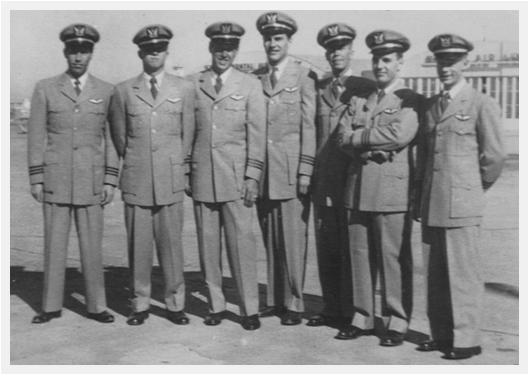
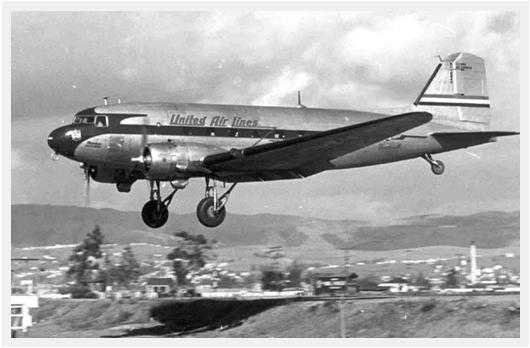
It was kind of funny, cuz he really wasn't all that familiar with United as an airline, and at first thought they were just a small regional airline. A little research showed that they were definitely a large carrier... he applied and was hired! It was a time when the airlines were rapidly growing and needed pilots badly. He was relatively inexperienced, but no matter, he was now in training to be a DC-3 co-pilot!
The top pic shows him in the middle with several of the guys from his DC-3 training class. He was just 23 years old, and his dream to be an airline pilot had already come true!
He liked the DC-3, but it sure was a world away from what airline aircraft are today. It could be cold and drafty, and in those days, almost everything you wanted to do was a lot of work. But that kid from the small town in Indiana was an airline pilot!
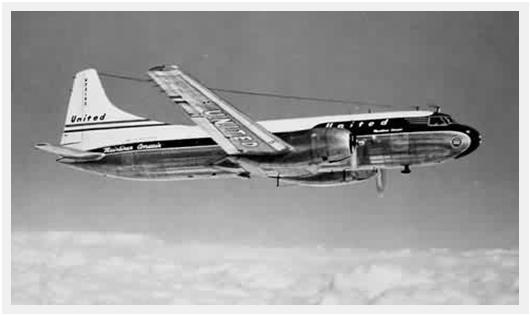
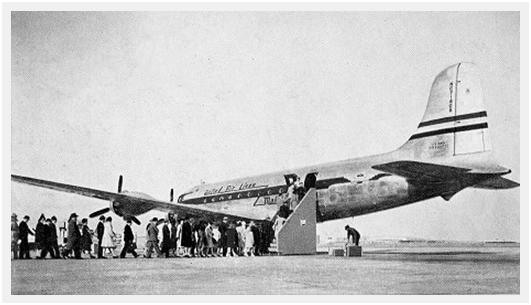

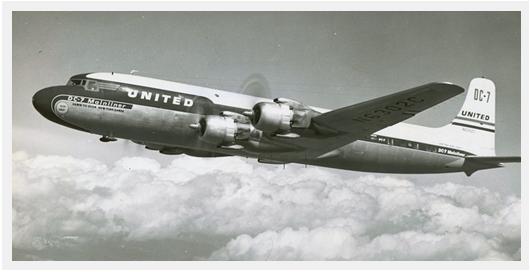
Through the mid and late 50's, my dad worked his way up the ladder getting rated on several of the aircraft that United was flying. He had moved to the Chicago area and was flying out of Midway airport.
The top pic shows the convair 340. He told me several times that the Convair was an airplane that wasn't going to ever leave the runway unless you made it do so. I think he liked t though.
The next pic shows the DC-4, the first of the new generation of tricycle geared Douglas Airliners. This is the only airliner I remembering him saying that he really didn't enjoy flying. They weren't around for very long. Sometime in the late 50's, he repositioned to the San Francisco area flying out of SFO.
Third pic down is the DC-6. Looks a lot like the DC-4, but seems it was bigger and had a pressurized cabin. With four Pratt & Whitney R-2800 engines making 2,500 hp each, the DC-6 could tote 60 to 80 people at a little over 300mph.
The bottom pic is the DC-7. Still not looking all that much different from the aircraft before it, but with four Wright R-3350 engines at about 3,400hp each, cruise for 80 to 100 people was now up to just over 350mph. It wouldn't be long tho before the jet age arrived!

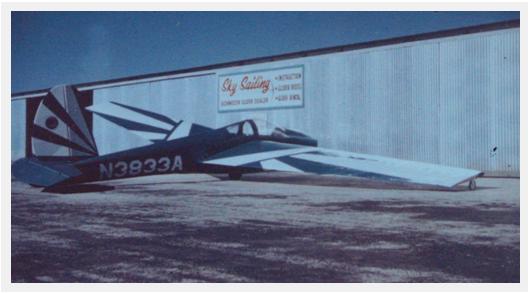
Far from the coming jet age was another side of aviation that my dad began back when he was at Purdue... gliders and sailplanes. Sometime in the late 50's, he bought a Schweizer 1-26 kit and built it. If I remember correctly, this was a kit, but all of the critical work was done at the factory, so when you finished, you actually had a certified airplane.
When he got it done, he moved it across the bay to Fremont, California to the Sky Sailing airport. They had the hills around the east side of the bay area that were excellent for ridge soaring with the west winds. The top pic shows him in the airplane right before the first flight. BTW, I really like this pic. In his typically, non-typical style, he flew that airplane on the test flight for a full 7 hours and 10 minutes! Not a 15 minute test hop, but a flight longer than many powered aircraft could even fly... and this was the very first flight! What a great accomplishment.
The bottom pic shows it after he added a full paint job. he flew the airplane for several years and then sold it. He was also flying other sailplanes out of Sky Sailing at Fremont, more on that later.
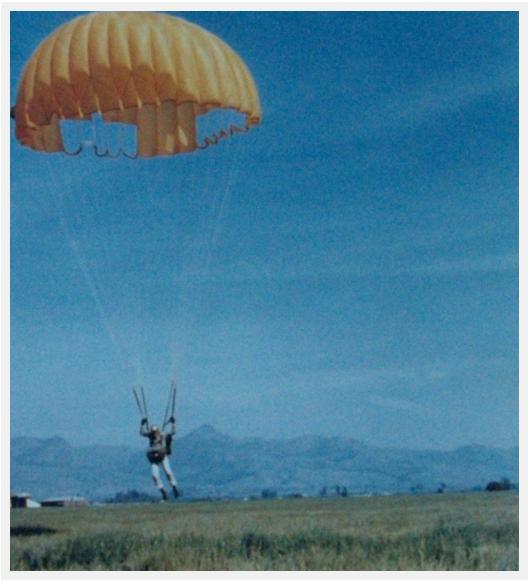

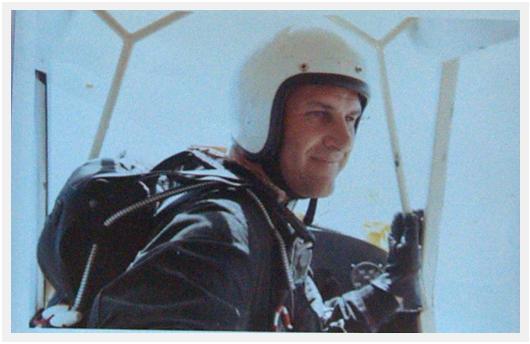

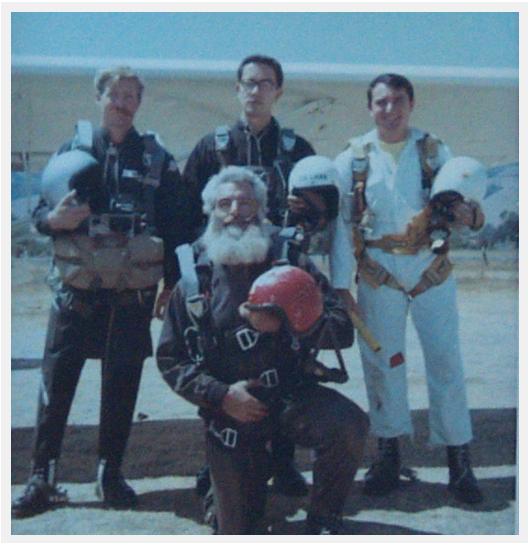
June 15, 1960 was the beginning of a whole new era for my dad... he made it first parachute jump that day. He loved it right away! It's here that you really start to get an understanding of the depth of his interest in flight. It's far more common to find people who are only interested in one aspect of aviation, but my dad was passionate about ALL of it!
I've said many times that he started jumping at a time when you pretty much HAD to be crazy to do it. The sport was still very primitive and the gear was somewhat awkward. It's fantastic to see how far the sport has come in 40+ years.
It was plenty safe tho, even in the early years, and he never had any serious trouble. He broke some bones once, but I'll save that for the book. He only got a total of 603 jumps in, but that was over total of 34 years... slow and steady!
The second pic shows the Aeronca Champ that he bought to use for fun flying and for jumping from. There was a young local instructor that would often fly my dad to jump into the countryside just outside Petaluma, California. I'm pretty sure he took the pic of my dad while climbing (slowly on 65hp!) to altitude.
Pop really liked that old gold 32 foot canopy from the early days of jumping. He dyed it himself with Rit dye in the bathtub!
The bottom pic shows 4 of the guys from the area that he used to jump with. It was really pretty amazing times and all of these people were really unique individuals!
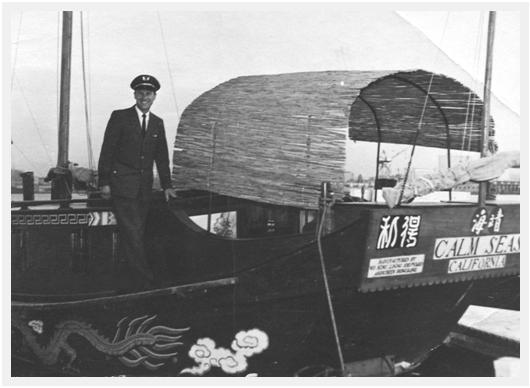
OK, it's true, this Chinese 'junk' never flew, but it is an interesting part of my dad's life. I'm intentionally not giving marriage specifics here cuz this isn't the place for the details (I may have to explain the marriage history in the book when I get it pulled together).
But it is true that my dad wasn't doing well with marriage overall... so here he is, not with an odd boat to play with, but an odd boat to live in! It's a little crazy, but he actually lived in this thing cuz it was extremely cheap and he didn't have much money at the time.

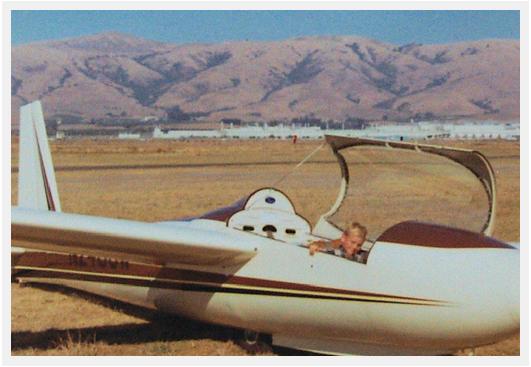
Here's more sailplane pics from Sky Sailing at Fremont about 1966. Pop was in a Bay Area soaring club and one of the airplanes they had was this Schweizer 2-32. I remember several rides up along the hills. He really enjoyed flying without an engine. The 2-32 is a pretty impressive aircraft. With a wide back seat capable of holding 2 smaller people, this 2-1/2 seater had very good performance. The first ones were built in '64, so this was a pretty big deal to be around in 1966.
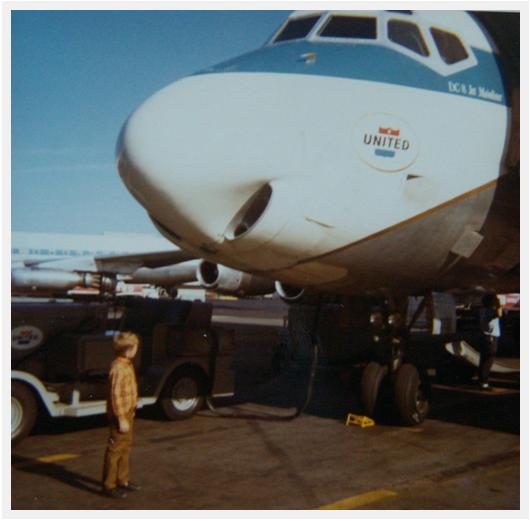
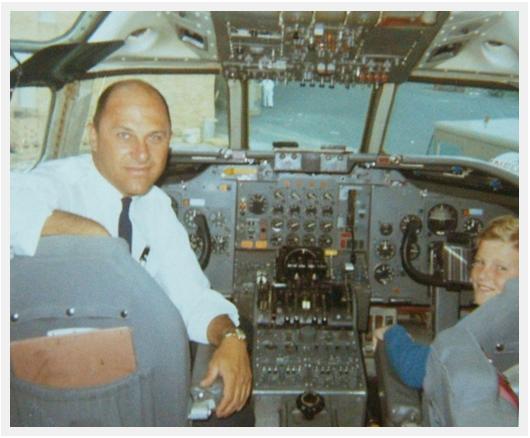
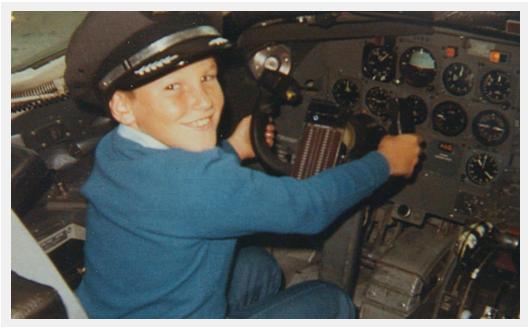
United had the Boeing 720, which was essentially the same as a 707, but my dad never flew them. His first jet experience was on the DC-8. One of the perks of having an airline pilot dad was the chance to go along on some of his trips. Since he was really just a big kid, we always enjoyed nosing around the airplane on the ground some to get a few pics. I got to see so many cool aircraft up close as a kid because of this. I used to love smelling the jet fuel and hearing the piercing whine of the turbines when I was young. In a strange way, it felt like home, even tho I never really wanted to fly for the airlines. Still, it was a pretty amazing time with the 70's fast approaching and jets in the air everywhere!

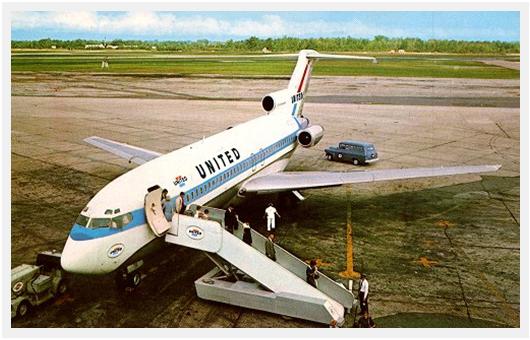
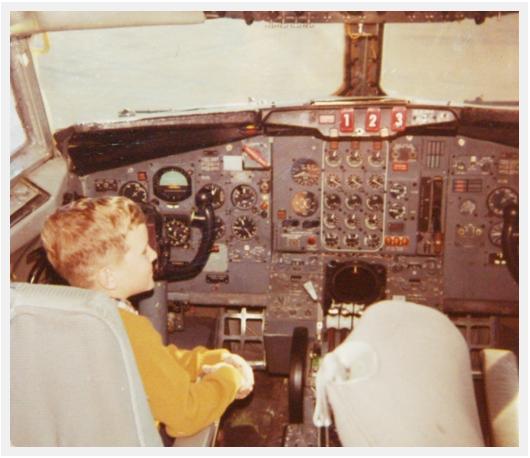
Right about 1970, pop moved south a little to fly out of LAX. He also transitioned to the Boeing 727 as Captain. I never really liked the Los Angeles airport, but I was a pretty big fan of the 727. It's a long story that I won't go into now, but when I was about 8 and 9 years old, I used to ride a 727 from SFO to LAX and back by myself every other weekend. I loved it! I always would sit on the left side, back row, right by the engine... I especially liked it when we landed and used reverse!
Speaking of 727's and reverse. At one point, pop was flying one into an airport that they didn't usually serve, and the tow bar on hand wouldn't fit a UAL 727. It was going to be a huge hassle to fly one in from another airport, but pop suggested that they try some gentle reverse thrust to get away from the terminal. Using great care (and no brakes to stop so it wouldn't fall back on the tail) he solved the problem in a jiffy! He was pretty creative at solving problems : )
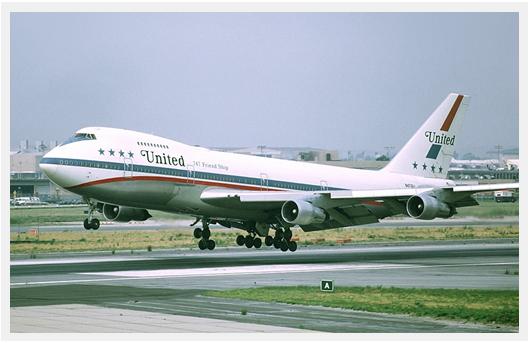
1970 also brought some really BIG changes... like the 747 finally arrives at United! We went out to LAX just to check it out and see up close what an incredible aircraft it was. I'm not sure I knew when we looked at it that day, but it wasn't actually gonna be very long before my dad would be sitting in the right seat of the most amazing airplane ever made.
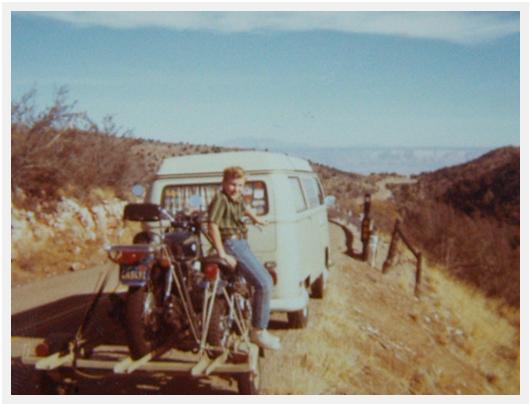
The next thing I knew, I was moving east with my dad to the Chicago, Illinois area and he was going to soon be in 747 school. I'm not sure how he worked it out, but I actually got to go thru the first 2 weeks of 747 school with him. I even got to make 3 take-offs and landings in the full motion 747 simulator... as a 10 year old! The incredible experiences that my dad opened the door on for me are almost too hard for even me to believe!
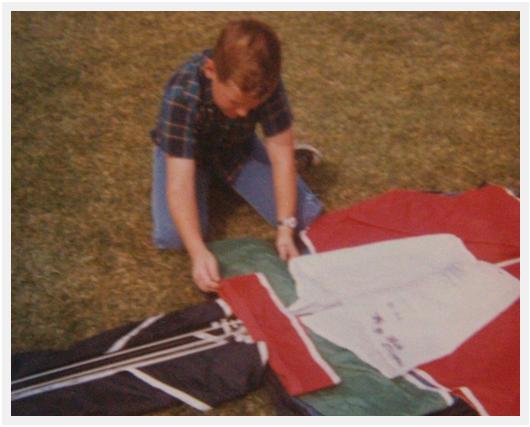
Here's another one of them... at age 10, he taught me how to pack his parachutes. Not just play around a little, but actually stretch it out, flake it, fold it properly, then sleeve it, stow the lines and put it in the container! And yes, he would jump it, and it would always work! He taught me so many things... and then trusted that I would do a good job.
He wasn't an ordinary dad, and because of that, I wasn't an ordinary kid.
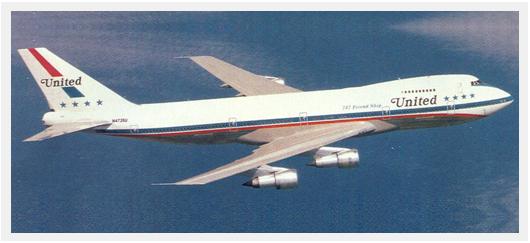

The era of the 747 had arrived and shortly after the airplane went online for United, pop was flying as co-pilot. To him, this was a nearly perfect airplane, one that he loved to hand-fly. In fact, many times, he would hand-fly the airplane (autopilot off) for long periods of time. He was extremely smooth with airplanes, and he taught me to be the same way. It was also obvious that flying was always a treat for him. Always.
It meant a lot to him to make the ride for the passengers as smooth as possible. One of his favorite things to do was make a landing so smooth that even he couldn't tell when they were on the ground. They'd only know when the spolier handle automatically moved. It was an even better landing if you could let it roll easy with little or no reverse thrust and braking. Easier on the airplane, easier on the passengers!
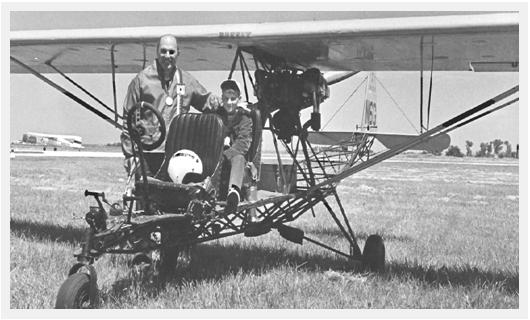
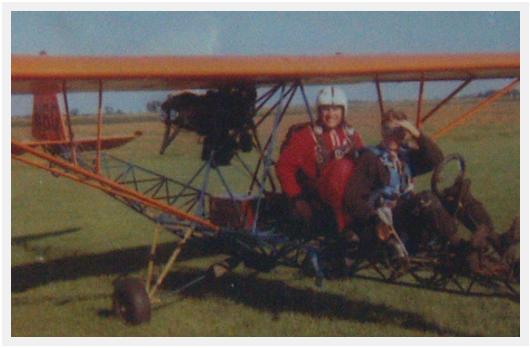

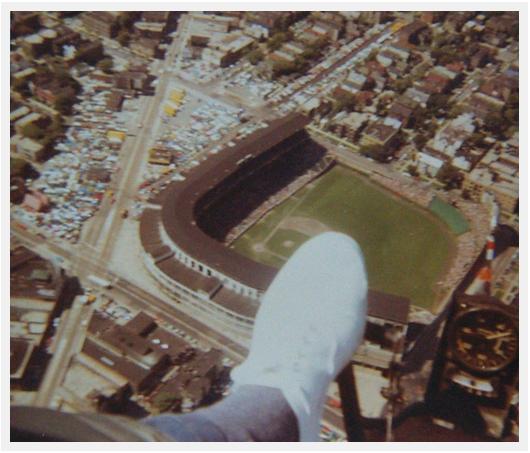
Another really big era soon started... the 'Breezy' era. The top pic shows me and pop with the first Breezy he bought. It was N6G, and had actually been the first one built from the plans. A guy named Jack Gardiner built it in California in the mid 60's. My dad had even seen it being built at one point, and now it was his!
It had a 90hp Continental engine and PA-12 Super Cruiser wings. I was still way too young to fly it, and it didn't have dual controls, but I sure rode all over the world on that thing! If I remember right, the fancy seats were from a T-34. The top pic was taken by longtime EAA photographer (and United pilot) Dick Stouffer who passed away in 2003.
This breezy was a little under-powered, but flew pretty well overall. Definitely not the best platform for carrying a jumper to altitude, but it sure was easy to get out (off!) of. The second pic shows pop getting ready to depart as the jumper and the third shows him flying it for a friend to jump from.
The bottom pic was taken by my dad as he flew it over downtown Chicago and Wrigley Field. I was on a scout trip to the game, so he flew over while I was there! I'm not sure what the deal is with those white shoes... but I know he was having fun. Pop was always doing something fun and a little bit crazy, but he was also always being careful.

This pic is interesting for a couple reasons. First, it's the same breezy, N6G, but pop had it repainted in an American stars and stripes theme. The bicentennial wasn't far off, so we were just getting ready a little early. Not sure who the rider is... between this and the second breezy coming later, we took literally thousands of people for rides over the years.
The last reason it's interesting is cuz that's me, at about age 12 getting ready to prop the airplane. Pop actually taught me to prop it while I was just 11 years old! I know, it sounds crazy, but I was extremely careful and never even came close to having a problem with it. You can just add it to the crazy list of aviation things I did when I was very young.
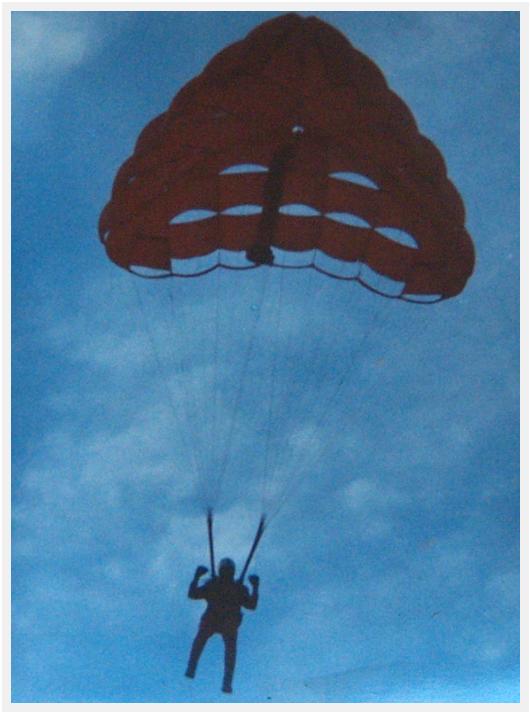
The 'square' parachute was almost here, but not quite. My dad thought this 'Thunderbow' looked like a good idea. It was sort of a 'round' parachute but also had a triangle shape, you know, for advanced performance. He was usually pretty quick to try something new.
Well, it turned it that it looked and sounded like a better idea than it really was. Overall, I think he liked it, but I seem to remember that he had a lot of hard landings with it. We didn't know it just yet, but the 'square' was gonna be the big answer.

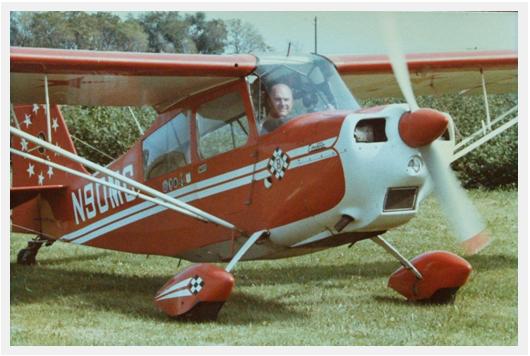
The year was now 1973, and that sweet stars and stripes breezy a few pics up wound up on its back in the big wind storm at the Burlington, Wisconsin fly-in. That's the same place and time that the Ford tri-Motor blew over... the EAA later rebuilt the Ford, but the Breezy got traded off needing a rebuild. So, the next thing I knew, we had a brand new Citabria 7KCAB on order.
I remember that we flew up to Minneapolis via the airline and then rode a cab out to Osceola, Wisconsin to the Bellanca factory. We took a nice tour of the plant and then off we went in a beautiful brand new red Citabria. The airplane was picked up as N86593, but soon we changed it to N90MC. The number '9' was a special number for us. Pop was born on March 9, I was born on February 9 (and even now, my wife was born on April 9!). Also interesting to note that both the 727 and 747 had their very first flights on February 9, my birthday.
So, pop got an 'N' number for the Citabria that had the '9' in it, and then, in his usual fashion, he thought of me and used my initials. All this came together even better when we soon after added another cool flying machine (sailplane) with the 'N' number of N91MC (see below).

So, I learned to fly mostly at age 13 in the Citabria with my dad as unoffical instructor. But I was also getting checked out in the summer of 1974 in gliders at the Hinkley, Illinois airport. Since my birthday is in the winter, and there aren't any sailplanes to fly in Illinois in the winter, we made plans to go south.
In February of 1975, we went to the Flying Seminole Ranch in Oviedo, Florida, and after a few thorough check rides, I was signed off for solo. On my 14th birthday, I flew that green and white Schweizer 2-33 all by myself - yay! Right after, I took pop for a ride in it so we could have a little of the fun together.
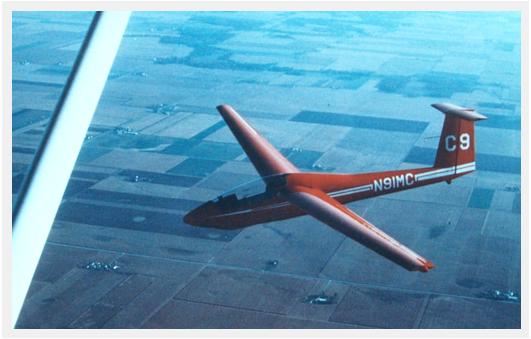
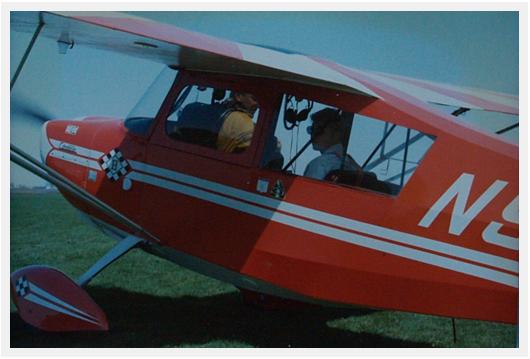
So, here's the absolutely stunning and awesome-flying Schweizer 1-35 sailplane that my dad bought new in 1975. And this one came straight from the factory with the special 'N' number that was sequential to the one on our Citabria, and it also had a competition number on the tail of C9.
Now we had a perfect combo of tow plane and sailplane. And to continue the crazy things my dad let me do at a young age, he had me flying that 1-35 in the summer of '75 when I was still just a 14 year old kid! It was fantatsic to fly... I loved it. It even had a retractable main wheel : ) My dad did a bunch of cool things with that airplane, and I'll get to that more when I get the book put together, but one cool thing was how he picked it up from Elmira, New York at the Schweizer factory. A good friend named Bob Alm (pretty sure that's him in the bottom pic about to fly pop to jump from the Citabria) had a Cessna 170 and they aero towed that 1-35 from New York to Illinois!
What an amzing adventure they had pulling it through the sky for about 600 miles! Again, my dad doing something unusual that worked great and having a good time doing it.

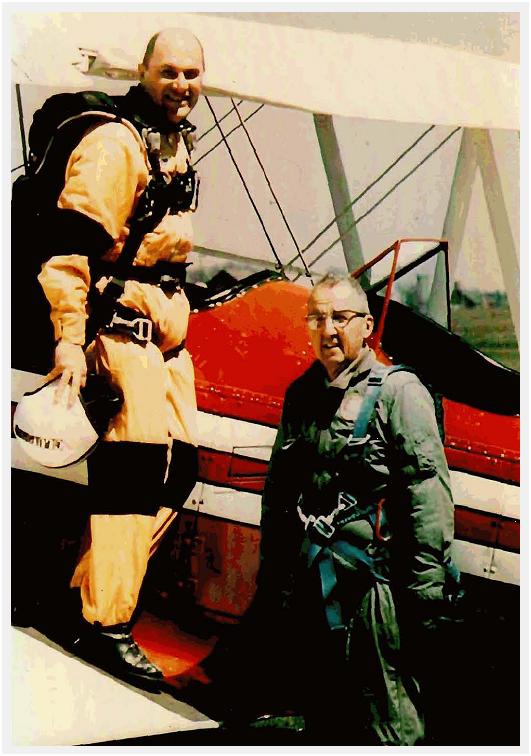


While all this fun flying was going on, my dad was also flying the 747 as co-pilot out of ORD and loving that too. He pretty much had it made with the job he had dreamed of, with good pay, and lots of fun flying toys for the days off. The pic at top shows him in the front office and wearing the 'newer' brown United uniform. (btw, he always liked the old blue ones better).
One of the 747 Captains that he flew with a lot was Ed Prose... he's in the second pic. Ed had a really nice Navy N3N and pop talked him into letting him jump from it. So, one fine summer day, out at the Hinckley, Illinois airport, that's just what he did! He loved it!
Fortunately, someone was able to get air to air pics of it so we can look at it today. The bottom pic isn't from that jump, but that is the Para Commander that he used that day. It's also cool to know that Ed later donated that N3N to the Navy Museum in Pensacola, Florida. They rebuilt it to all Navy specs and it's hanging up in the museum with a lot of other great aircraft.
My dad has stopped by many times to look at that airplane again, remembering the day when he got to make a parchute jump from it. In fact, he was just there again to see it in December of 2008, just 4 weeks before he passed away.

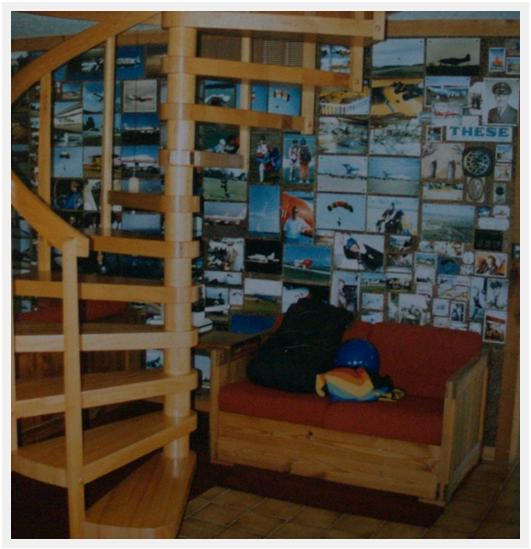

Another all new era began in late 1979 when my dad bought the small country airport in Mentone, Indiana. He'd always wanted a little airport to call home, but he also wanted to be back closer to his parents who still lived in that small Indiana town that he was born and raised in. We were a little under an hour away from them at Mentone.
The stories that would come out of living on that airport could easily fill a book. I'll just say now that it was a million great aviation experiences for a lot of people in those years there from 1979 thru the 80's. The second pic of the airport office wall, showing just some of the pictures gives a little idea of what life was like there. Pop was now junping a 'square' parachute, but he was also gaining a little weight. So, our new firend, John Eiff, who just happened to be a parachute designer and builder, built a custom canopy for him. Originally as a 7 cell, and then later adding the extra yellow cells to make it a 9 cell. This helped his getting-close-to-60 body take the landings a lot better.
Before he quit jumping at age 66, he had accumulated just over 600 jumps, including one from a Constellation and two from a 727... right out the airstairs in the back! Probably one of the few to be type rated in a 727 to actually jump from it too! It's just another part of his amazing story in the world of aviation.
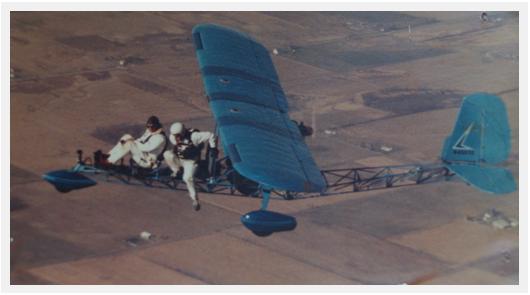
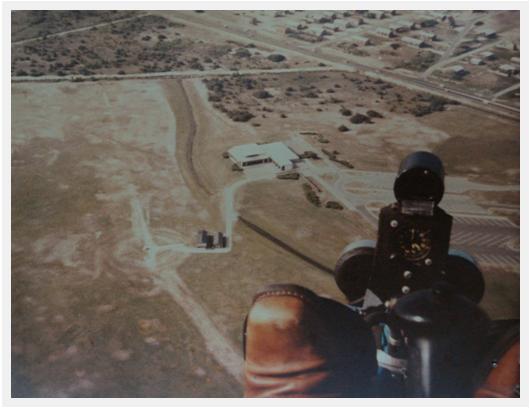
Shortly after moving to the Mentone Airport, he found another Breezy built by a guy in Alabama. It's really unfair to only show a couple pics of this airplane because it was the backbone of the fun flying done for years at the airport. We were always taking rides on it as well as taking trips in it. I took it to Oshkosh several years and pop took it on a couple of really long distance trips.
We also used it occasionally as a jump plane as seen in the top pic. My dad is flying, and our parachute building friend John Eiff is getting ready to jump. This Breezy had a 125hp Lycoming and Stinson 10A wings with flaps. Compared to the old Breezy N6G, N45870 was a real hot rod! So easy to fly, and it even looked 'racy' for a Breezy (especially with the spring steel gear legs and pants). It would also haul two people in the back seat with hardly a care.
The bottom pic is from one of my dad's long trips. Here he's flying right over the Wright Brothers Memorial and looking right at the site at Kitty Hawk, North Carolina where they first flew! Again, more amazing stuff from my dad's life.


The 747's were well into the new paint job by this time. In the early 80's, he was able to get a Captains bid and move from the right seat to the left seat. Wow! A 747 Captain... it doesn't get any better than that. For years as co-pilot, he flew the non-stop to Honolulu trip. After a few years of 'reserve' and misc. flying as Captain, he was able to fly the Tokyo (Narita) Japan route. He really liked the experience of flying to Japan.
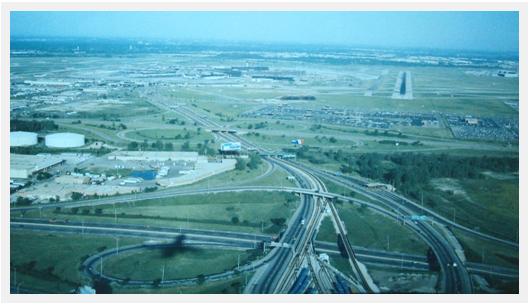
He snapped this pic from the left seat on approach to ORD. He was getting close to the end of his 35 year career at United Airlines.
'DC-3's to 747's, who could ask for more.'
He always liked this picture because he caught the shadow of the airplane going over the highway. He could hardly believe that he had spent 16 years flying the 747.

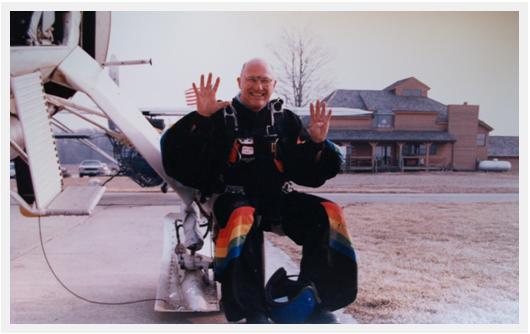
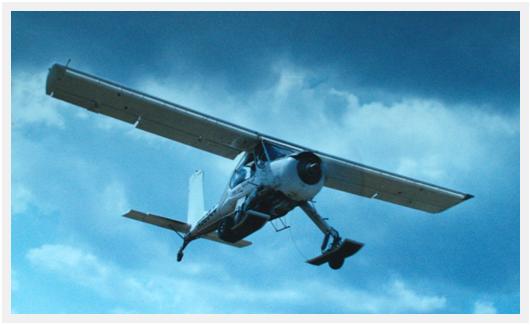
My dad retired from United Airlines a year and a half before turning 60. He had already reached 35 years of service and decided to get out while he was still healthy. Shortly after retiring, he bought a Polish PZL 104 Wilga 80.
It was so ugly it was ultra-cool. A sweet 260hp radial engine with a huge prop that turned backwards and two big mufflers! Everything about this airplane was odd, and we loved it.
For his 60th birthday, he wanted to key on that special number '9' again and make 9 parachute jumps, so the Wilga came in real handy for that. I flew him for 8 of the jumps from the Wilga right there on Mentone airport in front of a pretty big crowd of friends that had gathered for the occasion. The ninth jump was then made from the Breezy (that seat sure gets skinny at 4000'!). It was a pretty special 60th birthday party for my dad. I think he slept well that night too!
You can see in the top pic how comfortable he looked when he was in the air. Of all the things he did in the sky, jumping out of airplanes seemed to be his most favorite. I'm really glad he got to do it for so many years.
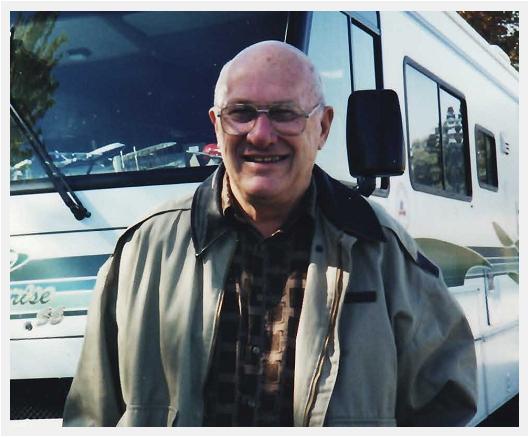
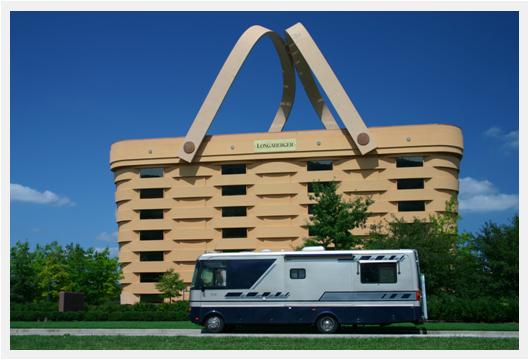

In the mid 90's, the airport was gone and then the house on the airport too. Things were streamlined a lot and he eventually bought a motorhome and lived only on the road. It gave him the freedom to travel all over and do many of the other things he'd always wanted to do. Along the way, he got loads of great pics from many beautiful locations around the country.
In a slightly odd twist, turned out he really liked Longaberger baskets... and especially enjoyed building them at the factory. They help you to make sure it's right, and then you have your very own Longaberger basket. He said he had built 72 of them over the years! That's probably some kind of a record. And just like he did with hundreds of little 'smiley' 747 pins, and lots of early flying man sculptures, and then 8x12 photos from around America, and lastly with these hand-made baskets, he gave them away to people he liked. It always made him happy to make others happy.
It was more of what he had taught me when I was a kid... be honest, treat people kindly, and trust Jesus. My dad was far from perfect, and he knew it, but he seemed to always be trying to move in the right direction, and knew that in the end, the best thing we can do is know that we have trusted that the sacrifice of Christ is the only thing that can save us on the day we stand before God.
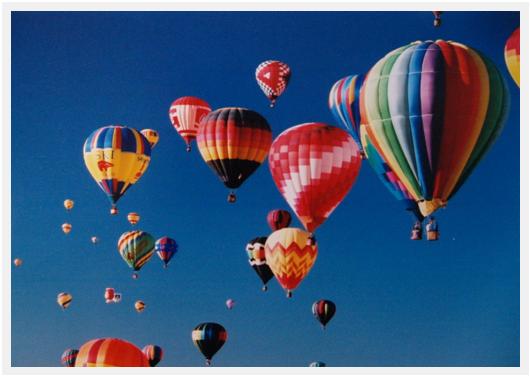

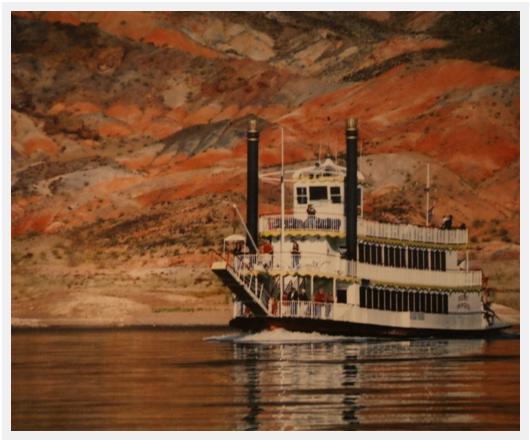

These are a few of the thousands of pictures my dad, Robert Clupper took while traveling across America waiting for God to call him home. Beautiful things he saw from this world. He lived a blessed life, and he knew it. He said many times he was ready to go, yet he never lost his passion for being here on earth. I pray that we all know how to live life while we're here, and even more important, know Who it is that gives life eternal.
Thank you, dad, for all you did for me. I love you.

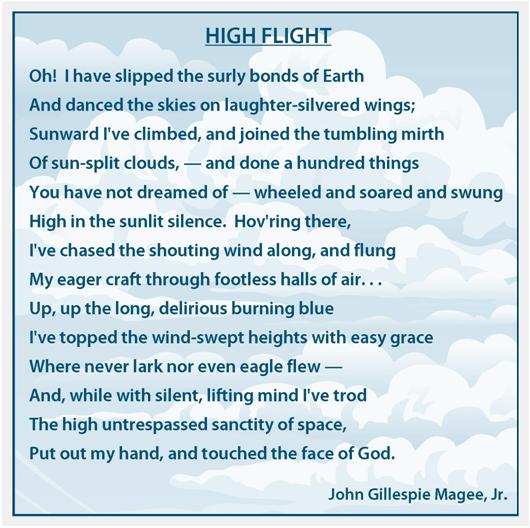
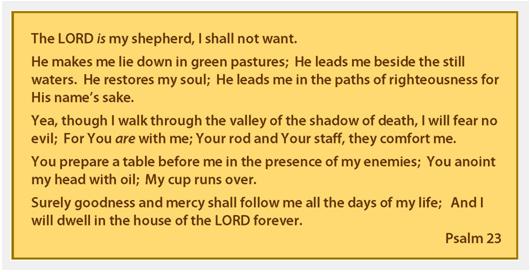
Robert James Clupper
March 9, 1929 - January 10, 2009
 Monday, February 2, 2009 at 07:30AM
Monday, February 2, 2009 at 07:30AM 






















































































































































